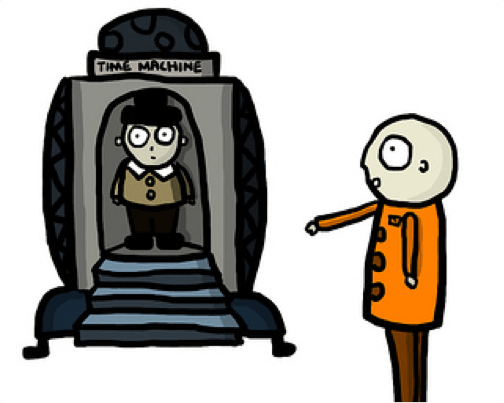This week I’ve been reading Global Environmental Politics: From Person to Planet, by State of the World 2013 contributor Simon Nicholson and Paul Wapner and it has proved an excellent read—with classic articles from a score of environmental experts, many of which have been on my ‘To Read’ list for a long time. But the hidden gem of the book resides on page 33. This being a college reader, each section ends with a thought exercise, with “The Time Machine,” wrapping up Section 1:
Imagine you are sitting in a time machine. You are required to make a choice. You can go back 300 years or forward 300 years. You can’t stay in the present, and once you have made your decision, you’re not coming back…. Which would you choose? To go forward or back?”
I had a lot of fun thinking through this. Though in truth, I would need just a bit more information before I could truly make my choice. Here’s my question: If I chose to go backwards in time would I get to influence the past, possibly even preventing the ecocidal present I’m now part of (kind of like that sci-fi show Continuum but set in Colonial America rather than modern-day Canada)? Perhaps I could become some sort of prophet that spreads a new ecological philosophy so that we never go down the suicidal grow-until-we-crash path. Possibly I could selectively introduce vaccines and antibiotics and sanitation—the best parts of the industrial revolution in my opinion—but decoupled from all the bad forms of progress that grew in parallel to this public health revolution. Or maybe I’d simply be shot or jailed as I tried to implement these changes. By 1714 the ideology of growth was well rooted and let’s be honest, I’m not sure how one would go from penniless time-immigrant to influential shaper of the future. If I was lucky, maybe I could sell enough future knowledge to buy up some of Manhattan before the island’s real estate market really took off. But probability of success aside, if you told me that there was any chance at all, I think I’d take it.
But let’s then assume the answer is no. That time is not linear and all is already as it ever will be. So if I went back in time, then that was always the case and I’ve already influenced it and it turned out as it turned out (You still with me? If not read here). In that case, I’d go forward. Certainly not because I think I’d be traveling to some sort of happy Star Trek future but just because I’m damn curious to see how the coming centuries unfold.
Call me suicidal if you will—the odds favor that if I left from Washington, I’d end up landing in the ocean (300 years from now I’d bet all the Manhattan real estate I bought in 1714 that Washington is underwater as Western or possibly all of Antarctica will most likely be ice-free by then). Or maybe I wouldn’t even be on a planet with a breathable atmosphere any longer. Or maybe I’d die from radioactive fallout still floating in the air from the nukes detonated during World War III.
Then again, if the collapse was slow and controlled rather than rapid and rabid, I might arrive thinking I pushed the “Backwards” button instead of the “Forward” one. With families farming little plots of land, dressed in home-tanned leather pants and homespun cotton shirts. But I’m sure a few minutes later I’d notice the well cared-for rifle or pair of binoculars—a family’s prize heirloom that has been well-used and passed on for generations. And once I turned my eyes toward the horizon, I’m sure I’d see some sharp angles of ruined skyscrapers hidden amongst the trees.
But is there any chance I’d see some sort of biomimickry-cradle-to-cradle-solar-organic utopia? I highly doubt it. While several chapters bring up the importance of hope in motivating us to build a sustainable future (“optimism makes us bigger,” blathers Alex Steffen, and Barbara Kingsolver has a whole essay on “How to Be Hopeful”), let’s be honest. More of the chapters—from Thomas Friedman’s essay “Too Many Americans?” to Bill McKibben’s “Global Warming’s Terrifying New Math”—reveal that the window for getting to a high-tech sustainable future has closed (if it was ever open in the first place). Instead, we may get to a sustainable future–but through a painful process of degrowth (with how painful that process being determined by who leads it–people or the planet).

An essay by Charles C. Mann beautifully explores this point. When any species is given unbridled access to resources, it grows until it is stopped by some competing force. As he notes, if nothing stopped the growth of a single Proteus vulgarisbacterium, in just 36 hours “this single bacterium could cover the entire planet in a foot-deep layer of single-celled ooze.” The same goes with humans, where, as Mann notes, our monocropped grain fields look similar to the Petri dishes that bacteria colonies completely fill up and then collapse in. Mann reflects on what biologist Lynn Margulis thought about whether we too would grow until we crash, “It would be foolish to expect anything else…. More than that it would beunnatural.”
Of course the point of the book is that global environmental politics, wielded well, may help prevent our eventual crash, or at least help steer our descent so the future looks more like Colonial Williamsburg than The Planet of the Apes (the original not the crappy remake). Let’s “hope” Nicholson and Wapner are right.
This post originally appeared on the Worldwatch Institute’s blog: Is Sustainability Still Possible?
Erik Assadourian is a Senior Fellow at the Worldwatch Institute and is teaching a course on Environmental Sustainability & Resilience at Goucher College this winter.
MAHB-UTS Blogs are a joint venture between the University of Technology Sydney and the Millennium Alliance for Humanity and the Biosphere. Questions should be directed to joan@mahbonline.org
MAHB Blog: https://mahb.stanford.edu/blog/time-machine/
The views and opinions expressed through the MAHB Website are those of the contributing authors and do not necessarily reflect an official position of the MAHB. The MAHB aims to share a range of perspectives and welcomes the discussions that they prompt.
